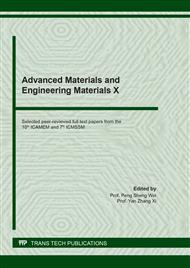[1]
Inagaki, M. and F. Kang, Chapter 1 - Introduction, in Materials Science and Engineering of Carbon, M. Inagaki and F. Kang, Editors. 2016, Butterworth-Heinemann. pp.1-6.
Google Scholar
[2]
Atkinson, J.D., et al., Evolution and impact of acidic oxygen functional groups on activated carbon fiber cloth during NO oxidation. Carbon, 2013. 54: pp.444-453.
DOI: 10.1016/j.carbon.2012.11.060
Google Scholar
[3]
Valdés, H., et al., Effect of Ozone Treatment on Surface Properties of Activated Carbon. Langmuir, 2002. 18(6): pp.2111-2116.
DOI: 10.1021/la010920a
Google Scholar
[4]
Berenguer, R., et al., A comparison between oxidation of activated carbon by electrochemical and chemical treatments. Carbon, 2012. 50(3): pp.1123-1134.
DOI: 10.1016/j.carbon.2011.10.025
Google Scholar
[5]
Hoseinzadeh Hesas, R., et al., The effects of a microwave heating method on the production of activated carbon from agricultural waste: A review. Journal of Analytical and Applied Pyrolysis, 2013. 100: pp.1-11.
DOI: 10.1016/j.jaap.2012.12.019
Google Scholar
[6]
Moreno-Castilla, C., M.V. López-Ramón, and F. Carrasco-Marı́n, Changes in surface chemistry of activated carbons by wet oxidation. Carbon, 2000. 38(14): pp.1995-2001.
DOI: 10.1016/s0008-6223(00)00048-8
Google Scholar
[7]
Sabzehmeidani, M.M., et al., Carbon based materials: a review of adsorbents for inorganic and organic compounds. Materials Advances, 2021. 2(2): pp.598-627.
DOI: 10.1039/d0ma00087f
Google Scholar
[8]
Pereira, M.F.R., et al., Adsorption of dyes on activated carbons: influence of surface chemical groups. Carbon, 2003. 41(4): pp.811-821.
DOI: 10.1016/s0008-6223(02)00406-2
Google Scholar
[9]
Velo-Gala, I., et al., Surface modifications of activated carbon by gamma irradiation. Carbon, 2014. 67: pp.236-249.
DOI: 10.1016/j.carbon.2013.09.087
Google Scholar
[10]
Girgis BS, T.Y., Gadelrab MM, Abdullah, X-ray Diffraction Patterns of Activated Carbons Prepared under Various Conditions. Carbon letters, 2007 Jun 30;8(2): p.:95–100.
DOI: 10.5714/cl.2007.8.2.095
Google Scholar
[11]
Ayiania, M., et al., Deconvoluting the XPS spectra for nitrogen-doped chars: An analysis from first principles. Carbon, 2020. 162: pp.528-544.
DOI: 10.1016/j.carbon.2020.02.065
Google Scholar
[12]
Ayiania, M., et al., Microstructural analysis of nitrogen-doped char by Raman spectroscopy: Raman shift analysis from first principles. Carbon, 2020. 167: pp.559-574.
DOI: 10.1016/j.carbon.2020.05.055
Google Scholar
[13]
Vega, E., et al., Adsorption of odorous sulfur compounds onto activated carbons modified by gamma irradiation. Journal of Colloid and Interface Science, 2015. 457: pp.78-85.
DOI: 10.1016/j.jcis.2015.06.037
Google Scholar
[14]
Oickle, A.M., et al., Standardization of the Boehm titration: Part II. Method of agitation, effect of filtering and dilute titrant. Carbon, 2010. 48(12): pp.3313-3322.
DOI: 10.1016/j.carbon.2010.05.004
Google Scholar
[15]
Goertzen, S.L., et al., Standardization of the Boehm titration. Part I. CO2 expulsion and endpoint determination. Carbon, 2010. 48(4): pp.1252-1261.
DOI: 10.1016/j.carbon.2009.11.050
Google Scholar
[16]
Tan, Z., et al., Mechanism of negative surface charge formation on biochar and its effect on the fixation of soil Cd. Journal of Hazardous Materials, 2020. 384: p.121370.
DOI: 10.1016/j.jhazmat.2019.121370
Google Scholar
[17]
Figueiredo, J.L., et al., Modification of the surface chemistry of activated carbons. Carbon, 1999. 37(9): pp.1379-1389.
Google Scholar
[18]
de la Puente, G., et al., Thermal stability of oxygenated functions in activated carbons. Journal of Analytical and Applied Pyrolysis, 1997. 43(2): pp.125-138.
DOI: 10.1016/s0165-2370(97)00060-0
Google Scholar
[19]
Moreno-castilla, C., et al., Effects of non-oxidant and oxidant acid treatments on the surface properties of an activated carbon with very low ash content. Carbon, 1998. 36(1): pp.145-151.
DOI: 10.1016/s0008-6223(97)00171-1
Google Scholar


